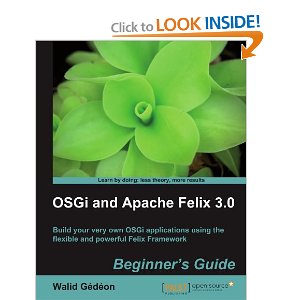 Book Description
Book Description
The OSGi specification is a module system and service platform that implements a complete and dynamic component model. Wasn’t that a complicated definition! So how would you really use it in practical modular applications? Let this book break down the seemingly overwhelming OSGi standards for you by explaining Apache Felix’s powerful architecture in a simple and easy-to-understand manner using Apache Felix framework to get you up and running sooner than you could expect.
The OSGi standards have found a wide range of applications in the context of the Enterprise, Telecommunications, Telematics, Smart Home, E-Health, and Mobile applications, to name just a few. Apache Felix is one of the most famous implementations of the OSGi framework specification. This book introduces OSGi on the simple and extensible Felix framework and guides you from the development environment setup to the troubleshooting of potential issues, walking you through the development of an OSGi-based application and explaining relevant software design concepts.
The book starts with an introduction to the OSGi Service Platform, its parts, and its bundle structure. It then walks you through setting up the Felix framework and your development environment. It describes the Felix Framework and how to operate it using Gogo. It will teach you everything possible about the practical implementation of OSGi using the Felix Framework as a launch pad.
The book then kicks off the Bookshelf project, a case study that will be used to progressively explain the important concepts around OSGi using the Felix framework. The Bookshelf project feature trail will set the context to explain OSGi headers, the bundle activator, the bundle context, and so on.
As you implement the bookshelf step by step, you learn about OBR repositories, dependency management, and bundle version management with Felix.
Moving ahead, a few more advanced topics are covered, such as using iPOJO for dependency injection and service registration; then the book moves on to the implementation of a web-based graphical interface, first using a simple Servlet, and then building a JSP-based Web Application Bundle.
OSGi service specifications such as the Log Service, Http Service, and Web Container are explained. Finally, the book describes some of the common pitfalls during bundle development, and gives hints on troubleshooting them in Felix.
A step-by-step beginner’s guide to implementing a real-life OSGi application, with the Apache Felix 3.0 framework
What you will learn from this book :
- Discover the practical implementations of important OSGi concepts
- Install , configure, and learn how to operate Felix using Gogo
- Understand how to use Maven to build and deploy OSGi bundles
- Create an OSGi-compliant application, brick by brick
- Learn how to implement JSP Web Application Bundles
- Dive deep into Felix iPOJO
- Understand Inversion of Control design patterns
- Get an overview of the Felix Web Management Console
- Get cozy with troubleshooting an OSGi application using Felix
Approach
This book is a step-by-step beginner’s guide based on developing a case study (a book inventory) that walks the developer through the implementation while progressively explaining the surrounding concepts in context. Throughout the book, the author discusses software design concepts and introduces productivity tools that build up the reader’s knowledge-base.
Who this book is written for
This book is aimed at Java developers looking to learn about writing reusable and network distributable software following the OSGi standards using the famous Felix framework. If you are a developer who wants to focus on the business logic, and abstract away from the details of how to integrate with specific systems then this book is meant for you.
If you are a Java developer new to OSGi and don’t really know where to start from to actually begin developing applications, just pick up this book and discover the ease with which you can start developing powerful, modular, and extensible applications. This book uses the Felix framework 3.0 as an OSGi service platform implementation and covers its usage to a level where it makes you comfortable enough to write your own enterprise-level applications.
Book Details
- Paperback: 336 pages
- Publisher: Packt Publishing (November, 2010)
- Language: English
- ISBN-10: 1849511381
- ISBN-13: 978-1849511384
- File Size: 7.4 MiB
- Hits: 1,218 times





0 comments:
Posting Komentar